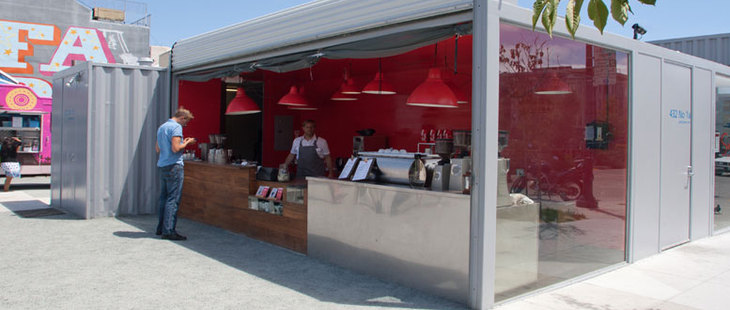
A barista asked if I had seen the shipping containers–the ones in the middle of the city. The ones that sold ice cream and coffee to patrons of a nearby park. This was confusing to me. I’ve seen shipping containers on docks and boats. Mobile commerce is not what shipping containers do. But there they were, in downtown San Francisco. And in hindsight, I can say that a shipping container sold me the smoothest ice cream I’ve ever had. In the neighbourhood of Hayes Valley, there are three of these containers. They sit on a gravel-strewn lot, surrounded by a modest chain link fence. More are on the way. Together they form Proxy, the brainchild of architect Douglas Burnham, and his Oakland-based firm, Envelope A+D. “It’s something that stands-in for something else,” explains Burnham, Envelope’s founder. “If you’re somebody’s proxy, you’re operating on their behalf while they’re not there.” The project is an experiment in renewable design and urban reclamation, a storefront without a street-a kind of urban improvisation that could find a home in other cities. But as impressive as this whole setup is, Proxy as it exists today is temporary. Five years from now, it will likely cease to exist. Condos, perhaps parking–or whatever the city decides to develop–will take its place. “Here for now,” says Burnham. And eventually gone-though not quite tomorrow. + The lot, located in Hayes Valley, a vibrant neighbourhood in the heart of San Francisco, is owned by the city. The city’s original plan was to see the land developed for condos through a design competition . But when the housing market tanked and property values sank, that kind of development became impractical. Until conditions improved, the city wanted something else to fill the space-but it was unsure of exactly what that might entail. Burnham’s firm, which was already involved with the site, was invited to present some ideas. They drew up a list: An outdoor cinema, pop-up stores, farmers’ markets, art installations, moveable urban furniture. But, with past experience as restaurant architects they kept coming back to food. Burnham preferred to build something that each vendor would own, and shipping containers made the most sense. Proxy’s first two storefronts were boutique food operations: Smitten Ice Cream sells nitrogen ice cream, which is flash-frozen in a matter of seconds, and made-to-order from scratch, while Ritual Coffee is one of San Francisco’s most popular local coffee roasters. A German biergarten is on the way. Construction begins with a typical 40 foot shipping container. The crate is halved, modified and polished offsite in Oakland, where the task is cheaper – but no less challenging. “All the infrastructure is missing. A raw shipping container has no insulation. There’s no electrical, no plumbing like a local building does,” says Smitten’s founder, Robyn Goldman. “It’s starting with absolutely nothing except metal.” To make matters worse, the city of San Francisco refused to accept Burnham’s containers as temporary buildings – the same class as most food trucks. The city defined “temporary” as just 90 days, far less than the Hayes Valley lease. This introduced another challenge for Burnham and his team: Each of the Proxy’s containers now had to meet the building code of a permanent building. That meant proper insulation, employee washroom facilities, and energy-efficient lighting. And because California is located on top a major fault line, the containers were required to meet seismic safeguards in the event of an earthquake. “It really slowed our process down, and it cost us a ton of money,” says Burnham. “I think, because no one has done it before, [the city] was kind of afraid.” He estimates that the bare-bones cost of outfitting each container would be around $40,000-50,000 – though much of the custom equipment used by Smitten’s nitrogen ice cream process has obviously increased that price. Still, the cost is still less expensive than renting and establishing a traditional storefront location. And most importantly, each of Envelope’s clients now owns their own containers. The only ongoing cost is rent-and when the current project ends, the merchants can pick up and reestablish themselves elsewhere. “When the project is over, we cut the umbilical cord,” says Burnham, “and [they] can have them set up on any lot, anywhere.” + In five years, the Hayes Valley lot will be empty-assuming the city choses to develop the property. Smitten and Ritual Coffee and other future tenants will unplug themselves from the city’s electrical grid, and detach their plumbing from the ground. A crane, parked nearby, will hoist each container from the ground and onto a flatbed truck. From there, they can go anywhere, true to Proxy’s promise. “It allows these things to be continued to be used beyond the lifespan of this project,” says Burnham. At Ritual Coffee, founder Eileen Hassi is unsure where her container will go next. She currently owns a traditional food truck called Sputnik for festivals and outdoor occasions, though she admits “we kind of have to rebuild it every time we set it up.” In five years time, her container could present a viable alternative – or at the very least, augment its use. “It’s an interesting way to attempt to expand. Find empty lots that are undervalued and drop a shipping container there,” reiterates Goldman. In other cities, where options for outdoor eats are less plentiful – or edible – a Proxy-style concept could enable a range of portable, culinary options that food carts alone can’t provide. “It took a hell of a lot of time to get the approval to do it, “Goldman admits. “But the benefit is you can reinvent what a space feels like.”














